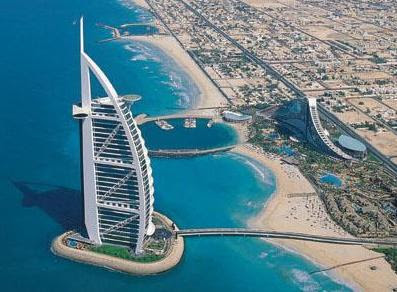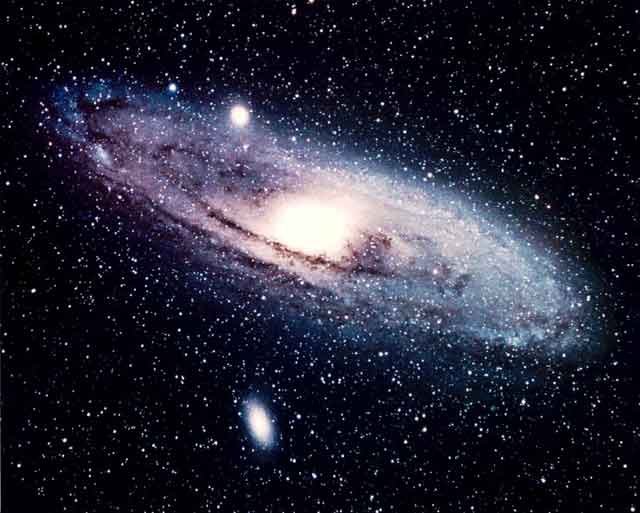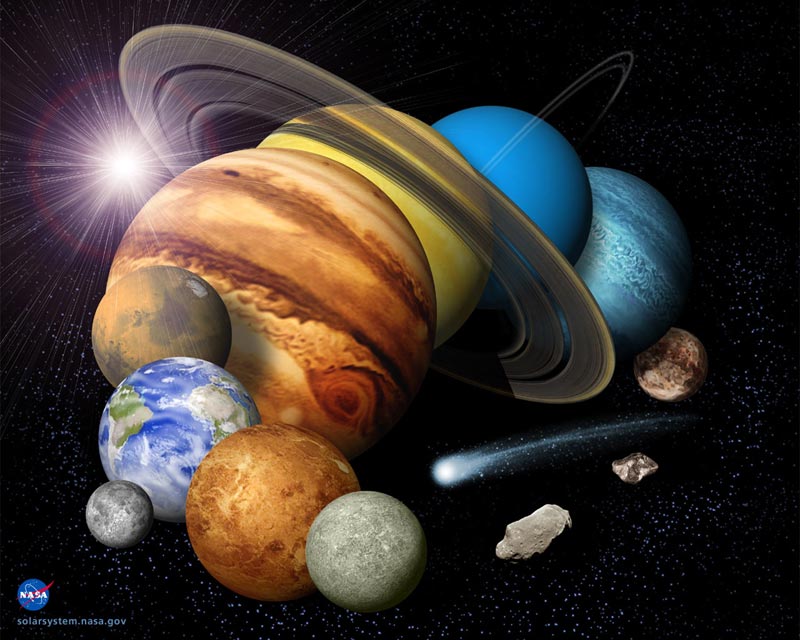The Vision
Climbers ascend a ribbon, 100,000 km long, strung between an anchor on Earth and a counterweight in space. Connecting Earth and space in a way never before possible, the space elevator will enable us to inexpensively and completely expand our society into space. 
Tuesday, November 25, 2008
The Space Elevator
White Hole
 In astrophysics, a white hole is the theoretical time reversal of a black hole. While a black hole acts as a vacuum, drawing in any matter that crosses the event horizon, a white hole acts as a source that ejects matter from its event horizon. The sign of the acceleration is invariant under time reversal, so both black and white holes attract matter. The only potential difference between them is in the behavior at the horizon.
In astrophysics, a white hole is the theoretical time reversal of a black hole. While a black hole acts as a vacuum, drawing in any matter that crosses the event horizon, a white hole acts as a source that ejects matter from its event horizon. The sign of the acceleration is invariant under time reversal, so both black and white holes attract matter. The only potential difference between them is in the behavior at the horizon.
Black hole event horizons can only "suck up" matter, while white hole horizons ostensibly recede from any incoming matter at the local speed of light, so that the infalling matter never crosses. The infalling matter is then scattered and reemitted at the death of the white hole, receding to infinity after having come close to the final singular point where the white hole is destroyed. The total proper time until an infalling object encounters the singular endpoint is the same as the proper time to be swallowed by a black hole, so the white hole picture does not say what happens to the infalling matter. Ignoring the classically unpredictable emissions of the white hole, the white hole and black hole are indistinguishable for external observers.
In quantum mechanics, the black hole emits Hawking radiation, and so can come to thermal equilibrium with a gas of radiation. Since a thermal equilibrium state is time reversal invariant, Hawking argued that the time reverse of a black hole in thermal equilibrium is again a black hole in thermal equilibrium.This implies that black holes and white holes are the same object. The Hawking radiation from an ordinary black hole is then identified with the white hole emission. Hawking's semi-classical argument is reproduced in a quantum mechanical AdS/CFT treatment, where a black hole in anti-de Sitter space is described by a thermal gas in a gauge theory, whose time reversal is the same as itself.
Wormhole
The term wormhole was coined by the American theoretical physicist John Wheeler in 1957. However, the idea of wormholes was invented already in 1921 by the German mathematician Hermann Weyl in connection with his analysis of mass in terms of electromagnetic field energy.
Stephen Hawking
 Born: 8 January 1942
Born: 8 January 1942
Birthplace: Oxford, England
Best Known As: The author of A Brief History of Time.
Fullname: Stephen William Hawking
Stephen Hawking is considered the world's foremost living theoretical physicist. He's an expert on black holes whose stated intention is to unify quantum mechanics with Einstein's general theory of relativity, forming a single theory to explain the origin (and end) of the universe. Hawking, a professor of mathematics at Cambridge University, is the author of the best-selling book A Brief History of Time and something of a celebrity: he has made guest appearances on the TV shows Star Trek and The Simpsons. Hawking has suffered from ALS (amyotrophic lateral sclerosis, also called Lou Gehrig's disease) since he was a young man and is confined to a wheelchair.
In 1979 Hawking took the post of Lucasian Professor of Mathematics at Cambridge. According to Hawking's own site, "The chair was founded in 1663 with money left in the will of the Reverend Henry Lucas, who had been the Member of Parliament for the University. It was first held by Isaac Barrow, and then in 1663 by Isaac Newton."
Further Reading
Stephen W. Hawking's work can best be approached by reading his books, which include Is the End in Sight for Theoretical Physics (1980); A Brief History of Time (1988); and Black Holes and Baby Universes and Other Essays; Sources on Hawking and his work include John Boslough, Stephen Hawking's Universe (1985); Alan Lightman and Roberta Brower, editors, Origins: The Lives and Worlds of Modern Cosmologists (1990); Michael Harwood, "The Universe and Dr. Hawking, " New York Times Magazine (January 1983); Elizabeth Devine, et al., editors, Thinkers of the Twentieth Century (1983); David Blum, "The Time Machine, " New York (October 1988); Kitty Ferguson, Stephen Hawking: A Quest for a Theory of the Universe (1992); Melissa McDaniel, Stephen Hawking: Physicist (1994); Harry Henderson, Stephen Hawking (1995). See also Russ Sampson, "Two Hours with Stephen Hawking, " Astronomy (March 1993); Publishers Weekly (February 12, 1996; March 10, 1997); Michael Lemonick, "Hawking Gets Personal, " Time (September 27, 1993); and Robert J. Deltete, "Hawking on God and Physical Theory, " Zygon (December 1995); Stephen Hawking also has his own web page at http://www.darntp.carn.ac.uk/user/hawking/home.html.
Monday, November 24, 2008
Metric expansion of space
 The metric expansion of space is the averaged increase of metric (i.e. measured) distance between objects in the universe with time. It is an intrinsic expansion—that is, it is defined by the relative separation of parts of the universe and not by motion "outward" into preexisting space. Metric expansion is a key feature of Big Bang cosmology and is modeled mathematically with the FLRW metric. This model is valid in the present era only at relatively large scales (roughly the scale of galactic superclusters and above). At smaller scales matter has clumped together under the influence of gravitational attraction and these clumps do not individually expand, though they continue to recede from one another. The expansion is due partly to inertia (that is, the matter in the universe is separating because it was separating in the past) and partly to a repulsive force of unknown nature, which may be a cosmological constant. Inertia dominated the expansion in the early universe, and according to the ΛCDM model the cosmological constant will dominate in the future. In the present era they contribute in roughly equal proportions.
The metric expansion of space is the averaged increase of metric (i.e. measured) distance between objects in the universe with time. It is an intrinsic expansion—that is, it is defined by the relative separation of parts of the universe and not by motion "outward" into preexisting space. Metric expansion is a key feature of Big Bang cosmology and is modeled mathematically with the FLRW metric. This model is valid in the present era only at relatively large scales (roughly the scale of galactic superclusters and above). At smaller scales matter has clumped together under the influence of gravitational attraction and these clumps do not individually expand, though they continue to recede from one another. The expansion is due partly to inertia (that is, the matter in the universe is separating because it was separating in the past) and partly to a repulsive force of unknown nature, which may be a cosmological constant. Inertia dominated the expansion in the early universe, and according to the ΛCDM model the cosmological constant will dominate in the future. In the present era they contribute in roughly equal proportions.
The metric expansion leads naturally to recession speeds which exceed the "speed of light" c and to distances which exceed c times the age of the universe, which is a frequent source of confusion among amateurs and even professional physicists. The speed c has no special significance at cosmological scales.
Tuesday, August 19, 2008
Today in History
 Sputnik 5 was the first spaceflight to send animals into orbit and return them safely back to Earth. Launched on August 19, 1960, it paved the way for the first human orbital flight less than eight months later with Vostok 1. Sputnik 5 was a USSR artificial Earth satellite from the Sputnik space program. It was in fact the second test flight of the Vostok spacecraft, and therefore it is sometimes called Korabl-Sputnik 2 ("korabl" is Russian for "ship").
Sputnik 5 was the first spaceflight to send animals into orbit and return them safely back to Earth. Launched on August 19, 1960, it paved the way for the first human orbital flight less than eight months later with Vostok 1. Sputnik 5 was a USSR artificial Earth satellite from the Sputnik space program. It was in fact the second test flight of the Vostok spacecraft, and therefore it is sometimes called Korabl-Sputnik 2 ("korabl" is Russian for "ship").
2 dogs - Belka ("Squirrel") and Strelka ("Little Arrow" or "Pointer")
40 mice
2 rats
A variety of plants
Mass: 4,600 kg
Perigee: 287 km
Apogee: 324 km
Inclination: 64.95°
Period: 90.72 minutes
NSSDC ID: 1960-011A
The spacecraft carried two dogs, Belka and Strelka, 40 mice, 2 rats and a variety of plants on-board. The spacecraft returned to earth the next day and all animals were recovered safely. The spacecraft also carried a television camera which took images of the dogs.
Shortly after the landing, one of Strelka's puppies was sent to Jacqueline Kennedy as a present from the Soviet Union.
Monday, August 11, 2008
World Facts
THE EARTH Estimated Weight (mass) (5,940,000,000,000,000,000,000 metric tons)
Estimated Age 4.6 billion years
Population 6,446,131,714
Surface Area (510,066,000 sq km)
Land Area (148,647,000 sq km) 29.1%
Ocean Area (335,258,000 sq km)
Total Water Area (361,419,000 sq km) 70.9%
Type of Water (97% salt), (3% fresh)

Circumference at the equator (40,066 km)
Circumference at the poles (39, 992 km)
Diameter at the equator (12,753 km)
Diameter at the poles (12,710 km)
Radius at the equator (6,376 km)
Radius at the poles (6,355 km)
Orbit Speeds
The earth orbits the Sun at (66,700 mph), (107,320 km per hour)
Sun Orbit
The earth orbits the Sun every 365 days, 5 hours, 48 minutes and 46 seconds
To convert km (kilometers) to miles, multiply kilometers by: 0.621371 To convert sq km (kilometers) to sq miles, multiply kilometers by: 0.386102
OCEANS OF THE WORLD (by size)
Pacific (155,557,000 sq km)
Atlantic (76,762,000 sq km)
Indian (68,556,000 sq km)
Southern (20,327,000 sq km)
Arctic (14,056,000 sq km)
Note the Southern Ocean was approved in 2000 by the International Hydrographic Organization. It is now the fourth largest ocean.
OCEANS' GREATEST DEPTHS
Mariana Trench, Pacific Ocean 35,827 ft
Puerto Rico Trench, Atlantic Ocean 30,246 ft
Java Trench, Indian Ocean 24,460 ft
Arctic Basin, Arctic Ocean 18,456 ft
DEEPEST OCEANS & SEAS
Pacific Ocean (35,827 ft) (10,924 meters)
Atlantic Ocean (30,246 ft) (9,219 meters)
Indian Ocean (24,460 ft) (7,455 meters)
Caribbean Sea (22,788 ft) (6,946 meters)
Arctic Ocean (18,456 ft) (5,625 meters)
South China Sea (16,456 ft) (5,016 meters)
Bering Sea (15,659 ft) (4,773 meters)
Mediterranean Sea (15,197 ft) (4,632 meters)
Gulf of Mexico (12,425 ft) (3,787 meters)
Japan Sea (12,276 ft) (3,742 meters)
MAJOR SEAS (by size)
South China (2,974,600 sq km)
Caribbean (2,515,900 sq km)
Mediterranean (2,510,000 sq km)
Bering (2,261,100 sq km)
Gulf of Mexico (1,507,600 sq km)
Arabian Sea (1,498,320 sq km)
Sea of Okhotsk (1,392,100 sq km)
Sea of Japan (East Sea) (1,012,900 sq km)
Hudson Bay (730,100 sq km)
East China (664,600 sq km)
Andaman (564,900 sq km)
Black (507,900 sq km) Red (453,000 sq km)
MAJOR ISLANDS (by size)
Australia, (7,617.930 sq km) is widely considered part of a continental landmass, not officially an island. But without doubt it is the largest island on the planet, and when combined with Oceania, the smallest continent on Earth. Greenland (2,175,600 sq km)
New Guinea (792,500 sq km)
Borneo (725,500 sq km)
Madagascar (587,000 sq km)
Baffin (507,500 sq km)
Sumatra (427,300 sq km)
Honshu (227,400 sq km)
Great Britain (218,100 sq km)
Victoria (217,300 sq km)
Ellesmere (196,200 sq km)
Celebes (178,650 sq km)
New Zealand (south) (151,000 sq km)
Java (126,700 sq km)
New Zealand (north) (114,000 sq km)
Newfoundland (108,900 sq km)
MAJOR RIVERS (By Length)
Nile, Africa (6,825 km)
Amazon, South America (6,437 km)
Chang Jiang (Yangtze), Asia (6,380 km)
Mississippi, North America (5,971 km)
Yenisey-Angara, Asia (5,536 km)
Huang (Yellow), Asia (5,464 km)
Ob-Irtysh, Asia (5,410 km)
Amur, Asia (4,416 km)
Lena, Asia (4,400 km)
Congo, Africa (4,370 km)
Mackenzie-Peace, North America (4,241 km)
Mekong, Asia (4,184 km)
Niger, Africa (4,171 km)
MAJOR LAKES (By Size)
Caspian Sea, Asia-Europe (371,000 sq km)
Superior, North America (82,100 sq km)
Victoria, Africa (69,500 sq km)
Huron, North America (59,600 sq km)
Michigan, North America (57,800 sq km)
Tanganyika, Africa (32,900 sq km)
Baikal, Asia (31,500 sq km)
Great Bear, North America (31,300 sq km)
Aral Sea, Asia (30,700 sq km)
Malawi, Africa (28,900 sq km)
Great Slave, Canada (28,568 sq km)
Erie, North America (25,667 sq km)
Winnipeg, Canada (24,387 sq km)
Ontario, North America (19,529 sq km)
Balkhash, Kazakhstan (18,300 sq km)
DEEPEST LAKES (By Greatest Depth)
Baikal, Russian Fed. (5,315 ft)
Tanganyika, Africa (4,800 ft)
Caspian Sea, Asia-Europe (3,363 ft)
Malawi or Nyasa, Africa (2,317 ft)
Issyk-Kul, Kyrgyzstan (2,303 ft)

CONTINENTS OF THE WORLD CONTINENTS (by size)
#1 Asia - (44,579,000 sq km)
#2 Africa - (30,065,000 sq km)
#3 North America - (24,256,000 sq km)
#4 South America - (17,819,000 sq km)
#5 Antarctica - (13,209,000 sq km)
#6 Europe - (9,938,000 sq km)
#7 Australia/Oceania - (7,687,000 sq km)
CONTINENTS (by population) 2005 est.
#1 Asia - (3,879,000,000)
#2 Africa - (877,500,000)
#3 Europe - (727,000,000)
#4 North America - (501,500,000)
#5 South America - (379,500,000)
#6 Australia/Oceania - (32,000,000)
#7 Antarctica - (0)
CONTINENTS (by the number of countries)
#1 Africa - (53)
#2 Europe - (46)
#3Asia - (44)
#4 North America - (23)
#5 Oceania - (14)
#6 South America - (12)
LARGEST COUNTRIES (by land mass)
Russia 17,075,400 sq km, (6,592,846 sq miles)
Canada 9,330,970 sq km, (3,602,707 sq miles)
China 9,326,410 sq km, (3,600,947 sq miles)
USA 9.166,600 sq km, (3,539,242 sq miles)
Brazil 8,456,510 sq km, (3,265,075 sq miles)
Australia 7,617,930 sq km, (2,941,283 sq miles)
India 2,973,190 sq km, (1,147,949 sq miles)
Argentina 2,736,690 sq km, (1,056,636 sq miles)
Kazakhstan 2,717,300 sq km, (1,049,150 sq miles)
Sudan 2,376,000 sq km, (917,374 sq miles)
SMALLEST COUNTRIES (by land mass)
Vatican City 0.44 sq km, (0.17 sq miles)
Monaco 1.95 sq km, (0.75 sq miles)
Nauru 21.2 sq km, (8.2 sq miles)
Tuvalu 26 sq km, (10 sq miles)
San Marino 61 sq km, (24 sq miles)
Liechtenstein 160 sq km, (62 sq miles)
Marshall Islands 181 sq km, (70 sq miles)
Seychelles 270 sq km, (104 sq miles)
Maldives 300 sq km, (116 sq miles)
St. Kitts and Nevis 360 sq km, (139 sq miles)
OLDEST COUNTRIES
San Marino (301 AD)
France (486 AD)
Bulgaria (632 AD)
Denmark (950 AD)
Portugal (1143 AD)
Andorra (1278 AD)
Switzerland (1291 AD)
YOUNGEST COUNTRIES Kosovo (February 2008)
Montenegro (July, 2006)
Serbia (July, 2006)
East Timor (2002)
Palau (1994)
Czech Republic (1993)
Eritrea (1993)
Slovakia (1993)
Bosnia/Hertzegovina (1992)
RICHEST COUNTRIES (GNP in USA Dollars)
Luxembourg ($45,360)
Switzerland ($44,355)
Japan ($41,010)
Liechtenstein ($40,000)
Norway ($34,515)
POOREST COUNTRIES (GNP in USA Dollars)
Mozambique ($80)
Somalia ($100)
Eritrea ($100)
Ethiopia ($100)
Congo, DNC ($100)
COUNTRIES WITH MOST LAND BORDERS (The Most Neighboring Countries) China (14) Russia (14)
Brazil (10)
Congo, Germany and Sudan (9)
Austria, France, Tanzania, Turkey and Zambia (8)

TOP 10 TALLEST MOUNTAINS
Mount Everest 8850m (29035ft) Nepal/China
Qogir (K2) 8611m (28250ft) Pakistan
Kangchenjunga 8586m (28169ft) Nepal
Lhotse 8501m (27920ft) Nepal
Makalu I 8462m (27765ft) Nepal
Cho Oyu 8201m (26906ft) Nepal
Dhaulagiri 8167m (26794ft) Nepal
Manaslu I 8156m (26758ft) Nepal
Nanga Parbat 8125m (26658ft) Pakistan
Annapurna I 8091m (26545ft) Nepal
The dormant volcano Mauna Kea (on the Big Island of Hawaii) could be considered the tallest mountain in the world. If you measure it from its base in the Hawaiian Trough (3,300 fathoms deep) to its summit of 13,796 feet, it reaches a height of 33,476 feet.
TALLEST MOUNTAINS (On Each Continent)
Mount Everest 8850m (29035ft) Asia
Aconcagua 6959m (22831ft) S. America
Mount McKinley 6194m (20320ft) N. America
Mount Kilimanjaro 5963m (19563ft) Africa
Mount Elbrus 5633m (18481ft) Europe
Puncak Jaya 4884m (16023ft) Oceania
Vinson Massif 4897m (16066ft) Antarctica
LANGUAGES OF THE WORLD Languages spoken by the most people (Native speakers only)
Chinese Mandarin 1 billion +
English 512 million
Hindi 501 million
Spanish 399 million
Russian 285 million
Arabic 265 million
Bengali 245 million
Portuguese 196 million
Malay-Indonesian 140 million
Japanese 125 million
German 100 million
Vietnamese 83 million
Korean 78 million
French 77 million
Chinese, Wu 77 million
Javanese 75 million
Chinese. Yue 71 million
COUNTRIES (Highest Density) (people per square km)
Monaco 16,205
Singapore 6,386
Malta 1,261
Maldives 1,164
Bahrain 1,035
Bangladesh 1,002
Vatican City 920
Barbados 648
Nauru 621
Mauritius 603
COUNTRIES (Lowest Density)(people per square km)
Mongolia 2
Namibia 2
Australia 3
Botswana 3
Iceland 3
Suriname 3
Libya 3
Mauritania 3
Canada 3
Guyana 4
COUNTRY POPULATION (smallest) (February, 2006 numbers)
Vatican City 920
Tuvalu 11,640
Nauru 13,050
Palau 20,300
San Marino 28,880
Monaco 32,410
Liechtenstein 33,720
St. Kitts 38,960
Marshall Islands 59,070
Antigua and Barbuda 68,720
COUNTRY POPULATION (largest) (February, 2006 numbers)
China 1,306,313,800
India 1,080,264,400
USA 295,734,100
Indonesia 241,973,900
Brazil 186,112,800
Pakistan 162,419,900
Bangladesh 144,319,600
Russia 143,420,300
Nigeria 128,772,000
Japan 127,417,200
LARGEST DESERTS OF THE WORLD (SUBTROPICAL)
Sahara, North Africa 3,500,000 sq. miles
Arabian, Middle East 1,000,000 sq. miles
Great Victoria, Australia 250,000 sq. miles
Rub'al Khali, Middle East 250,000 sq. miles
Kalahari, Southern Africa 225,000 sq. miles
Syrian, Middle East 200,000 sq. miles
Chihuahuan, Mexico 175,000 sq. miles
Thar, India/Pakistan175,000 sq. miles
Great Sandy, Australia 150,000 sq. miles
Gibson, Australia 120,000 sq. miles
Sonoran, S.W. USA 120,000 sq. miles
Mohave, S,W, USA 54,000 sq. miles
(COOL COASTAL)
Atacama, Chile SA 54,000 sq. miles
Namib, S.W. Africa 13,000 sq. miles
(COLD WINTER)
Gobi, China 500,000 sq. miles
Patagonian, Argentina 260,000 sq. miles
Great Basin, S.W. USA 190,000 sq. miles
Kara-Kum, West Asia 135,000 sq. miles
Colorado, Western USA 130,000 sq. miles (also called the Painted Desert} Taklamakan, China 105,000 sq. miles
Iranian, Iran 100,000 sq. miles
Longest Wedding Dress and Most valuable pair of jeans
 Most valuable pair of jeans
Most valuable pair of jeans
WHO:
Levi Strauss & Co
WHAT:
$60,000 (£33,230)
WHERE:
USA
WHEN:
June 15, 2005
An original pair of Levi Strauss & Co (USA) 501 jeans aged over 115 years old were sold by Randy Knight (USA) to an anonymous collector (Japan) for $60,000 (£33,230) through internet auction site eBay on June 15, 2005.
Longest Wedding Dress Train WHO:
WHO:
Andreas Evstratiou
WHAT:
1,362 m (4,468 ft 5.94 in)
WHERE:
Paphos, Cyprus
WHEN:
February 18, 2007
The longest wedding dress train measured 1362 m (4468 ft 5.94 in) and was created by Andreas Evstratiou (Cyprus) of the bridal shop, Green Leaf, in Paphos, Cyprus, on the February 18, 2007.
Sunday, August 10, 2008
World's Most Luxurious, Tallest and First 7 Star Hotel
 The Burj Al Arab is a most luxurious and first 7 star hotel in the world located in Dubai, United Arab Emirates. At 321 metres (1,053 ft), it is the tallest building used exclusively as a hotel. However, the Rose Tower, also in Dubai, which has already topped Burj Al Arab's height at 333 m (1,090 ft), will take away this title upon its opening. The Burj Al Arab stands on an artificial island 280 metres (919 ft) out from Jumeirah beach, and is connected to the mainland by a private curving bridge. It is an iconic structure, designed to symbolize Dubai's urban transformation and to mimic the sail of a boat.
The Burj Al Arab is a most luxurious and first 7 star hotel in the world located in Dubai, United Arab Emirates. At 321 metres (1,053 ft), it is the tallest building used exclusively as a hotel. However, the Rose Tower, also in Dubai, which has already topped Burj Al Arab's height at 333 m (1,090 ft), will take away this title upon its opening. The Burj Al Arab stands on an artificial island 280 metres (919 ft) out from Jumeirah beach, and is connected to the mainland by a private curving bridge. It is an iconic structure, designed to symbolize Dubai's urban transformation and to mimic the sail of a boat.
The hotel cost $650 million to build.
 The Rose Tower is a 333 metre (1,093 feet), 72-story skyscraper on Sheikh Zayed Road in Dubai, United Arab Emirates. Originally, the tower was to be 380 m (1,247 feet) high, but its projected height was reduced in further design modification. Construction began in 2004. ACC (Arabian Construction Co.) was the general contractor. On 24 October 2006, the building reached its full height with the addition of the spire. Although the tower was expected to open in April 2008, it still had not opened by July 2008. Once open, it is expected to become the world's tallest hotel. This hotel, known as "Rose Rotana Suites," will surpass both the 321 m (1,053 ft) Burj Al Arab, and the incomplete 330 m (1,083 ft) Ryugyong Hotel in Pyongyang, North Korea.
The Rose Tower is a 333 metre (1,093 feet), 72-story skyscraper on Sheikh Zayed Road in Dubai, United Arab Emirates. Originally, the tower was to be 380 m (1,247 feet) high, but its projected height was reduced in further design modification. Construction began in 2004. ACC (Arabian Construction Co.) was the general contractor. On 24 October 2006, the building reached its full height with the addition of the spire. Although the tower was expected to open in April 2008, it still had not opened by July 2008. Once open, it is expected to become the world's tallest hotel. This hotel, known as "Rose Rotana Suites," will surpass both the 321 m (1,053 ft) Burj Al Arab, and the incomplete 330 m (1,083 ft) Ryugyong Hotel in Pyongyang, North Korea.World's Smallest Post Office
 The World's Smallest Post Office is in Ochopee Florida 34141. It was formerly an irrigation pipe shed for the J.T. Gaunt tomato farm. The 8'4" x 7'3" building was converted to a Post Office in 1953. There is room for one postal worker and one customer inside.
The World's Smallest Post Office is in Ochopee Florida 34141. It was formerly an irrigation pipe shed for the J.T. Gaunt tomato farm. The 8'4" x 7'3" building was converted to a Post Office in 1953. There is room for one postal worker and one customer inside.



















